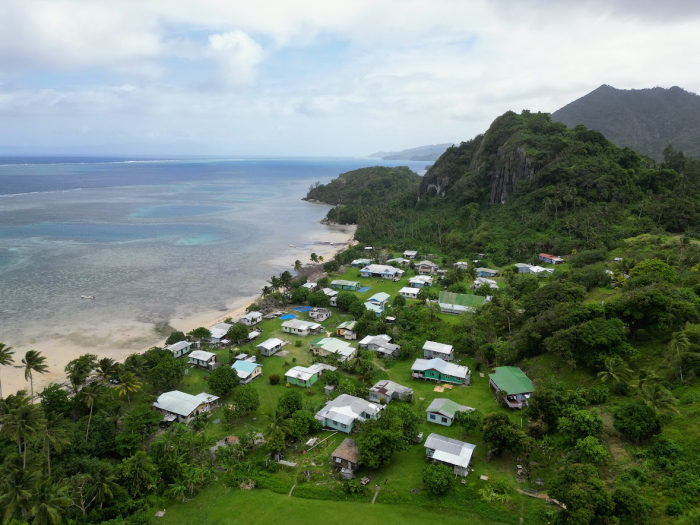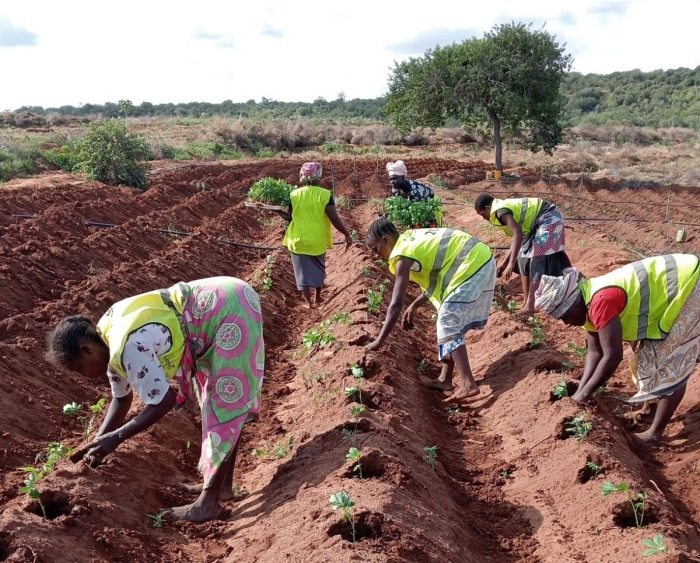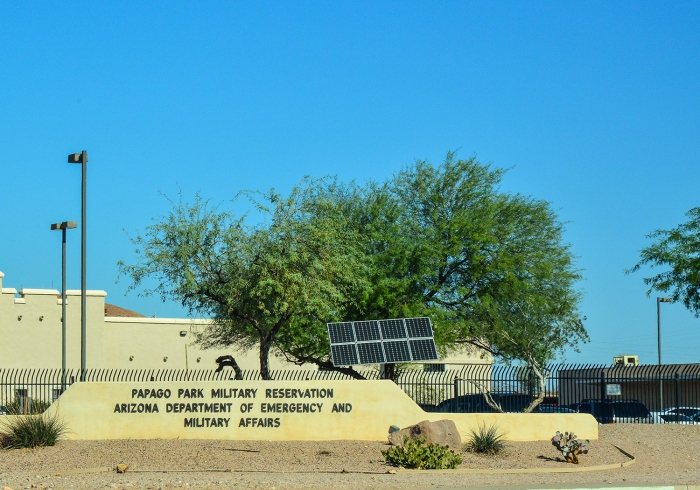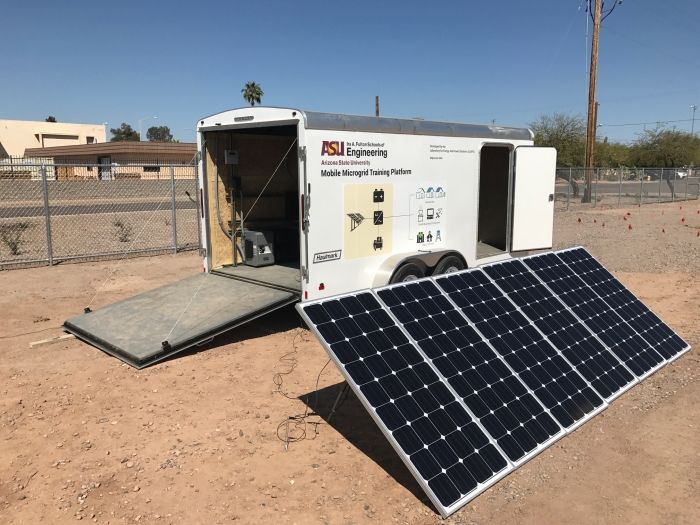This ASU lab brings the energy

Alexander Mobley (right) and former student researcher (now graduated) Cody Van Cleve verify safety conditions for one of the MEDUSA (Modular Energy Distribution Utility Simulation Apparatus) experimental power system's electrical panels. Photo courtesy of the Laboratory for Energy And Power Solutions
Across the world, around 750 million people — more than twice the population of the United States — lack access to electricity. For many more, access is unreliable or unsustainable. Faced with such monumental need, Arizona State University’s Laboratory for Energy And Power Solutions (LEAPS) decided to take a unique approach.
The lab, part of the Ira A. Fulton Schools of Engineering, emphasizes turning ideas into on-ground solutions with impact. Nathan Johnson, director of the lab, wants LEAPS to model a new way for a university to engage in the energy space.
By the numbers
An estimated 100,000 people are set to benefit from LEAPS projects across over 100 sites.
“Most people see a university only in terms of research and education,” says Johnson, who is also an associate professor in The Polytechnic School and the assistant director of research at the Julie Ann Wrigley Global Futures Laboratory. “I think, as a public institution, we need to do more to create public value.”
To that end, the lab partners with stakeholders to create the right solution through a combination of technology, business models and policy. LEAPS then steps in to fill the gaps where needed — whether it’s a piece of equipment, a national energy plan or training. All efforts include partnerships outside ASU, including the private sector, nonprofits, co-ops and governments of all levels.
Whether bringing electricity to an off-grid community or modernizing a grid to use cheaper, greener energy, the lab’s unwavering mission is to address the United Nations’ Sustainable Development Goal 7: universal access to clean energy.
“All of our goals are relatively the same,” Johnson says. “Safe, reliable, clean, affordable and resilient access to energy.”
Reaching remote communities
Last year, the lab was selected to lead phase one of the Fijian government’s project to electrify all its rural communities by 2030. Their herculean task: to assess close to 300 remote communities in need of reliable power and prioritize 75 to deploy the first round of mini grid installations. The project was sponsored by the U.S. Trade and Development Agency.
Read more: 'Empowering the Pacific'
Mini grids are small power grids that can run separately from major grids like the ones that electrify our cities. Often, they’re powered by hybrid sources like solar panels, batteries and diesel generators.
Once they arrived at a potential site, the team worked with local residents to understand their electric needs, whether they wanted to participate and if there was land available to build a mini grid. The team also partnered with COMET to give communities practical insights about using mini grids.
The 75 sites were chosen based on the population and presence of schools or health centers while also ensuring that sites were spread across the entire country. In total, the sites cover 30 islands.
The team estimates that replacing the sites’ unreliable diesel power generators with more sustainable mini grids will decrease carbon dioxide emissions by over 9,300 tons per year.
Besides being better for the planet, these mini grids are resilient to extreme weather like typhoons. Designed with help from small business partner Xendee, the grids boast underground wiring, sturdy construction and backup power modes.
In the project’s next phase, private companies will be able to bid for the opportunity to construct the mini grids.
"These projects plan to use a partnership agreement between the Fijian government, a private sector partner and communities represented by an electric cooperative,” says Elena van Hove, director of global energy access at LEAPS. “This is an innovative partnership model to leverage the strengths of each entity.”
Guiding a nation's strategy
In addition to providing power grid solutions, LEAPS also supports countries in their transitions to low- and zero-carbon economies. In the latest example, the LEAPS team worked with Madagascar’s government to develop a plan to provide nationwide access to clean energy by 2030. The project was funded by United Nations Sustainable Energy for All.
In Madagascar, most people use traditional fuels like charcoal or firewood to cook their food in inefficient stoves. This not only emits more carbon dioxide, but also exposes people to health risks from breathing in smoke. Less than 5% of the country has access to clean cooking sources.
Partnering with National Rural Electric Cooperative Association (NRECA) International, the team gathered data on Madagascar’s current cooking methods and population growth, and used these insights to map out each region’s needs and renewable fuel potential. This geospatial analysis provided a master plan with actionable steps to meet the nation’s goals.
“With these maps, we wanted to show that Madagascar can meet these clean cooking goals through domestic potential,” says Arnel Garcesa, a graduate student at The Polytechnic School who worked on the project.
The plan empowers each region to meet its energy needs at the lowest cost. For example, a region with a large agricultural sector could use local sugarcane to produce bioethanol or crop waste to create clean-burning biomass fuel.
The team’s final product, called the Integrated Energy Plan, was presented to the government of Madagascar and officially adopted in July. The nation is now considering its next steps to implement the plan and has secured funding for the first round of pilots and commercial deployments.
Growing women-owned energy businesses
The LEAPS team is passionate about growing local ownership and capacity in all its efforts. That’s why one of the lab’s latest projects is to provide resources and support for women-owned businesses in Kenya’s energy industry.
“In the energy sector in Kenya, women are a very small group of workers compared to men. So if we want to bridge that gap, we should help women entrepreneurs,” says Marlon Acevedo Rios, a senior engineer in LEAPS.
The lab worked through USAID’s Power Africa program as part of an effort to reduce gender inequalities.
By partnering with Factor[e] Ventures, an investment firm supporting local capacity growth in Nairobi, the team was able to connect with three energy startups owned by women and active in Kenya.
60Hertz provides software tools to improve microgrid maintenance and troubleshooting, and is working on creating an app. SunCulture designs and services solar energy systems and irrigation solutions for smallholder farmers, promoting renewable energy and enhancing productivity. And Giraffe Bioenergy trains women to grow cassava and establish an ethanol biorefinery to create a local supply of ethanol and biofertilizers.
For this early stage of the project, each business was given a $50,000 grant. But Acevedo Rios knows that new business owners often have needs that money alone can’t fix, like technical assistance, business support and training tailored to their specific needs and development stage.
To help these entrepreneurs thrive, the lab is serving as a solutions broker. After identifying the unique needs of each business, the team is working to connect them with resources and collaborators from the ASU community who can support these needs.
If this pilot project is successful, Acevedo Rios hopes to present their work to USAID’s Power Africa program and offer it as a recipe for supporting gender equity in the energy workforce in regions around the world.
Preparing for emergency power outages
Closer to home, LEAPS is developing an energy management system that saves money, improves resilience and increases efficiency, all while contributing to our national defense.
The team partnered with the Papago Park Military Reservation for the Arizona Department of Emergency and Military Affairs to combine a building automation system with a separate microgrid energy system. The project was sponsored by the Environmental Security Technology Certification Program, which helps validate new technologies that target the environmental needs of the U.S. Department of Defense.
A major goal of the new, combined system is to extend the amount of time that the base can run on backup power during an emergency outage. Current regulation requires that bases be able to sustain critical missions for seven to 14 days in the event of an extended utility outage.
The energy system uses machine learning to predict the next day’s energy use and renewable energy generation, then uses that prediction to optimize use of energy assets in the present. It’s a technology that could find many other uses in the future.
Looking to partner with the lab or work at LEAPS as a staff member or student researcher? Reach out to asuleaps@asu.edu.
“It can be a household or it can be up to a full campus or an installation. We've been able to create the approach in an adaptable, modular way that can apply to a lot of different use cases,” says James Nelson, director of technology and innovation at LEAPS.
In fact, the team is applying that same work in households, commercial spaces, off-grid communities, ASU campus buildings and more.
Based on billing data from its first few months of deployment, the system reduced peak demand by up to 35% and energy consumption by up to 42% compared with similar months before the deployment.
“If this solution delivers on all points, we would want to integrate this technology as a matter of course on all future systems to save resources, increase resiliency and potentially even positively affect scoping in design,” says Randall Handorf, the utilities engineering supervisor at the base. “We’re looking forward to continuing our partnership with (LEAPS) and addressing other areas of concern.”
Testing and training
To help meet the needs of the growing renewable energy industry, the lab is teaching K–12 students about possible careers, upskilling workers who need to keep up with rapid developments and educating veterans and active-duty military personnel.
Did you know?
LEAPS is training around 1,000 working professionals and transitioning military veterans per year. Sponsors of LEAPS training include federal entities like the Department of Energy, the Department of Defense and the Environmental Protection Agency, as well as utilities, technology developers, regulators and trade groups.
The lab specializes in training that develops both knowledge and skills using virtual tools and hands-on exercises. Learners can practice their skills at the LEAPS test bed, located on the ASU Polytechnic campus. Or, if Arizona is far away, the live training could hit the road and come to the trainees.
One of the test bed’s hands-on tools is the mobile training trailer, a 15-foot unit that houses a microgrid system made from replaceable components.
“It’s designed to be destroyed a little bit,” says Alexander Mobley, the associate director of technology evaluation and workforce development at LEAPS. Experiencing the unexpected is one approach LEAPS uses to help train people how to think.
“I’ll purposely sabotage the trailer system — in a safe manner — so that it won’t work as expected, and then I have them learn how to troubleshoot the system by restoring it,” Mobley says. As a veteran, engineer, educator and PhD student, he is passionate about making fun lessons that are approachable and useful.
Another tool at the lab’s test bed is a larger experimental power system named MEDUSA — the Modular Energy Distribution Utility Simulation Apparatus. While often used for training, MEDUSA is also used by LEAPS researchers to test new ways to optimize energy grids. Third parties like the Army and private companies have used it to test their equipment safely on the isolated network.
It’s a huge advantage to be able to do this testing and refining before taking a piece of software or equipment to be formally certified by a larger lab, Mobley says.
“Being able to go from an idea to ‘let's test it out a little bit’ to ‘let's actually deploy it’ is not common in most research spaces,” he adds.
Interested in collaborating on this project? Contact the LEAPS Lab team at asuleaps@asu.edu.
More Environment and sustainability

Driving green desalination
Wilderness survival TV show hosts, pirates and water treatment researchers agree on one thing: Most natural water sources are not safe for drinking. Among the many potential risks is the high salt…

ASU preservation facility serves as test bed for rooftop heat mitigation
A roof coating that uses thermal energy storage materials from Arizona State University spinout EnKoat is halting the heat in several ASU buildings — including a section of the university’s largest…

ASU Carbon Summit displays sustainability leadership, collaboration and ... electric motorcycles
This month, a student-led initiative brought government officials, entrepreneurs and nongovernmental organizations under one roof to discuss sustainable carbon solutions. The annual Carbon…




